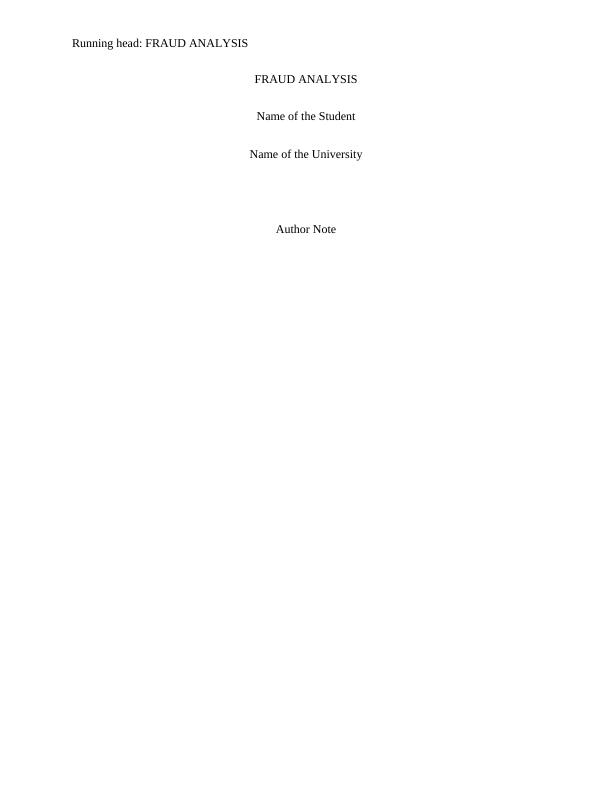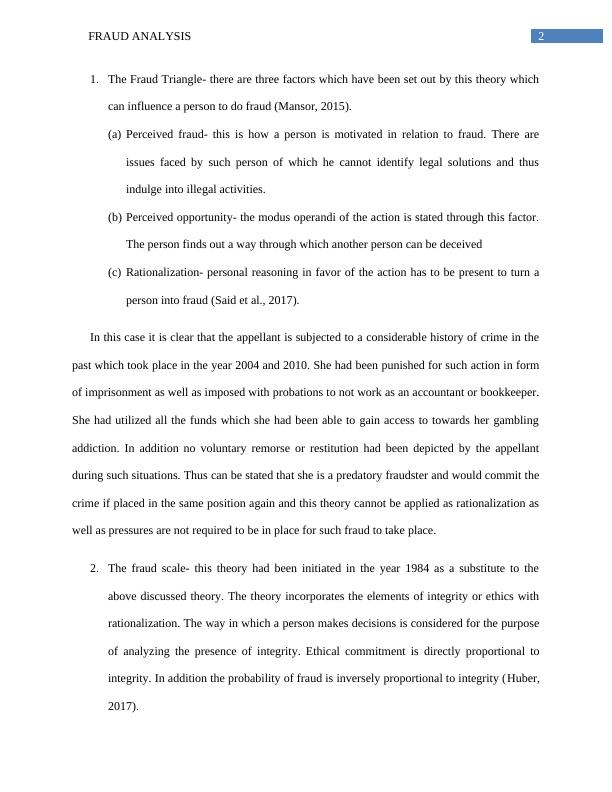Fraud Analysis: Theories and Case Studies
Added on 2023-06-15
6 Pages1346 Words387 Views
Running head: FRAUD ANALYSIS
FRAUD ANALYSIS
Name of the Student
Name of the University
Author Note
FRAUD ANALYSIS
Name of the Student
Name of the University
Author Note

1FRAUD ANALYSIS
A: Facts of the Case
In the case of R. v. Inshanalli, 2017 ONCJ it had been held by the court that the appellant
was guilty of committing fraud which amounted to $5000 which was contrary to the provisions
of s 380(1)(a) of the criminal code as well as violation of probations which had been applied on
her and thus violating the provisions of s. 733.1(1)(a) of the Criminal Code.
The appellant was employed by the victim as a bookkeeper/controller from 2014 April to
2016 January where she had been dismissed with respect to the identification of her fraudulent
activities which she indulged into during her course of employment. The discovery was that
about 134 cheques had been written by her which were not authorized and ranged from $1456.00
to $5839.28. 125 of the 134 cheques had forged signatures of the victim Gerard Waslens’ done
by the appellant.
The appellant in this case Ms. Inshanalli who is 62 years of age also have a history of
committing the same kind of offence in the past. She had in 2004 indulge into fraudulent activity
which involved stealing of $750,000 for the company she had been employed in and had been
subjected to two years of imprisonment. In 2010 she had also indulged in fraudulent activities
where she had been sentenced to an eighteen month period along with a probation which stated
that she is no longer eligible to work in the position of an accountant or bookkeeper.
B: Fraud Theory Analysis
The application of a number of theories can be done in the situation for the purpose of analyzing
the actions of the person committing the fraud and understanding how and why were such
actions initiated.
A: Facts of the Case
In the case of R. v. Inshanalli, 2017 ONCJ it had been held by the court that the appellant
was guilty of committing fraud which amounted to $5000 which was contrary to the provisions
of s 380(1)(a) of the criminal code as well as violation of probations which had been applied on
her and thus violating the provisions of s. 733.1(1)(a) of the Criminal Code.
The appellant was employed by the victim as a bookkeeper/controller from 2014 April to
2016 January where she had been dismissed with respect to the identification of her fraudulent
activities which she indulged into during her course of employment. The discovery was that
about 134 cheques had been written by her which were not authorized and ranged from $1456.00
to $5839.28. 125 of the 134 cheques had forged signatures of the victim Gerard Waslens’ done
by the appellant.
The appellant in this case Ms. Inshanalli who is 62 years of age also have a history of
committing the same kind of offence in the past. She had in 2004 indulge into fraudulent activity
which involved stealing of $750,000 for the company she had been employed in and had been
subjected to two years of imprisonment. In 2010 she had also indulged in fraudulent activities
where she had been sentenced to an eighteen month period along with a probation which stated
that she is no longer eligible to work in the position of an accountant or bookkeeper.
B: Fraud Theory Analysis
The application of a number of theories can be done in the situation for the purpose of analyzing
the actions of the person committing the fraud and understanding how and why were such
actions initiated.

2FRAUD ANALYSIS
1. The Fraud Triangle- there are three factors which have been set out by this theory which
can influence a person to do fraud (Mansor, 2015).
(a) Perceived fraud- this is how a person is motivated in relation to fraud. There are
issues faced by such person of which he cannot identify legal solutions and thus
indulge into illegal activities.
(b) Perceived opportunity- the modus operandi of the action is stated through this factor.
The person finds out a way through which another person can be deceived
(c) Rationalization- personal reasoning in favor of the action has to be present to turn a
person into fraud (Said et al., 2017).
In this case it is clear that the appellant is subjected to a considerable history of crime in the
past which took place in the year 2004 and 2010. She had been punished for such action in form
of imprisonment as well as imposed with probations to not work as an accountant or bookkeeper.
She had utilized all the funds which she had been able to gain access to towards her gambling
addiction. In addition no voluntary remorse or restitution had been depicted by the appellant
during such situations. Thus can be stated that she is a predatory fraudster and would commit the
crime if placed in the same position again and this theory cannot be applied as rationalization as
well as pressures are not required to be in place for such fraud to take place.
2. The fraud scale- this theory had been initiated in the year 1984 as a substitute to the
above discussed theory. The theory incorporates the elements of integrity or ethics with
rationalization. The way in which a person makes decisions is considered for the purpose
of analyzing the presence of integrity. Ethical commitment is directly proportional to
integrity. In addition the probability of fraud is inversely proportional to integrity (Huber,
2017).
1. The Fraud Triangle- there are three factors which have been set out by this theory which
can influence a person to do fraud (Mansor, 2015).
(a) Perceived fraud- this is how a person is motivated in relation to fraud. There are
issues faced by such person of which he cannot identify legal solutions and thus
indulge into illegal activities.
(b) Perceived opportunity- the modus operandi of the action is stated through this factor.
The person finds out a way through which another person can be deceived
(c) Rationalization- personal reasoning in favor of the action has to be present to turn a
person into fraud (Said et al., 2017).
In this case it is clear that the appellant is subjected to a considerable history of crime in the
past which took place in the year 2004 and 2010. She had been punished for such action in form
of imprisonment as well as imposed with probations to not work as an accountant or bookkeeper.
She had utilized all the funds which she had been able to gain access to towards her gambling
addiction. In addition no voluntary remorse or restitution had been depicted by the appellant
during such situations. Thus can be stated that she is a predatory fraudster and would commit the
crime if placed in the same position again and this theory cannot be applied as rationalization as
well as pressures are not required to be in place for such fraud to take place.
2. The fraud scale- this theory had been initiated in the year 1984 as a substitute to the
above discussed theory. The theory incorporates the elements of integrity or ethics with
rationalization. The way in which a person makes decisions is considered for the purpose
of analyzing the presence of integrity. Ethical commitment is directly proportional to
integrity. In addition the probability of fraud is inversely proportional to integrity (Huber,
2017).

End of preview
Want to access all the pages? Upload your documents or become a member.
Related Documents
Fraud Case Analysis Zarmoon Inshanallilg...
|4
|1226
|351
Case Discussion: Fraud Theory Analysis and Rational Choice Theorylg...
|7
|1370
|462
Fraud Theory Analysis: A Case Study of R v. Inshanallilg...
|7
|1462
|458
Ethical Dilemma in communication Presentation 2022lg...
|8
|750
|24
Tyco Corporate Scandal Case Analysis 2022lg...
|7
|1846
|36
Criminal Law: Liability of Matilda and Samlg...
|15
|3120
|152
